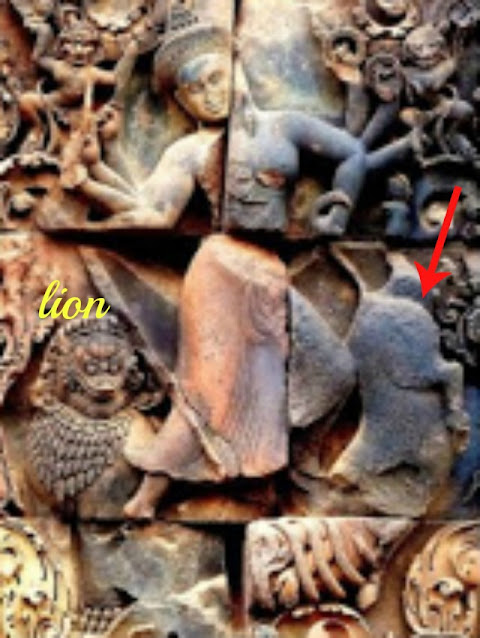Next we move to the innermost enclosure or make our way through the eastern gopura I.
A perfect bas relief on pediment for entering a Shiva temple in the central tower.





The tympanum on opposite side of gopura I (#B indicated in Figure 1 above) on western side (opposite tympanum #A) shows the slaying of demon Mahishasur by Goddess Durga. The lintel depicts God Hayagriva slaying two demons Madhu and Kaitabh. This can also be viewed from inside the central sanctuary towards east.
Mahishasur -- Mahisha (महिश): a buffalo, asur(असुर): demon with body of a buffalo
So, Mahishasur means demon with body of a buffalo.
Mahishasur wanted to wage war against the devtas (gods) and for that he performed severe penance and asked Lord Brahma for the boon of immortality. Brahma said immortality was not possible but he would be killed by a woman.
Mahishasur scoffed but was relieved, as being killed by a woman was next to impossible since there was no one who could match his strength. He started his atrocities against the devas, as they are the enemies of asurs.
When his atrocities became too much, the devtas went to the Trimurti (Brahma, Vishnu and Shiva) and asked to be relieved of Mahishasur. The trinity combined their energies and gave rise to a woman, Durga who came on her mount, lion, and slayed Mahishasur.
Goddess Durga is depicted with eight arms which is clearly seen in the above picture. The arms hold various weapons.The hind portion of the slayed asur in the form of a buffalo can be seen where the arrow points. Lion, her mount is seen on the side.
contd. to Prasat Banteay Srie 4, Siem Reap
Figure 1
The ornate carving on tympanum (#A above in Figure 1) depicts Shiva doing Ananda Tandava (आनंदताण्डव).A perfect bas relief on pediment for entering a Shiva temple in the central tower.

Lord Shiva on a pediment just before entering the innermost enclosure
Kaal mukh and garuda on the side panel
Kaal mukh and garuda on the side panel

Shiva doing Ananda tandava
In this form Shiva dances with enjoyment in contrast to Rudra tandava where he dances in a violent mood. Ananada tandava, where he dances with joy.
Tandava is a dance form by Shiva. That is why Shiva is also considered as the master of dancers, Nataraja. Nataraja means the King of dancers.

The pediment on gopuram on the eastern side shows Shiva (#1) in Nataraj or the dancing pose. A drummer is seen below (#2). On to the left is his disciple, Karaikal Ammaiyar(#3).

Karaikal Ammaiyar was one of the only three lady saints who propounded the worship of Shiva during the Bhakti Movement. The tradition of placing Karaikal Ammaiyar has been observed in some Shiva temples in India built during the Chola empire which reached its zenith during 10th to 12th century. That means this concept influenced the architecture of Banteay Srie.

on lintel is a headless form
Goddess Durga as Mahishasur Mardini:The tympanum on opposite side of gopura I (#B indicated in Figure 1 above) on western side (opposite tympanum #A) shows the slaying of demon Mahishasur by Goddess Durga. The lintel depicts God Hayagriva slaying two demons Madhu and Kaitabh. This can also be viewed from inside the central sanctuary towards east.
Mahishasur -- Mahisha (महिश): a buffalo, asur(असुर): demon with body of a buffalo
So, Mahishasur means demon with body of a buffalo.
Mahishasur wanted to wage war against the devtas (gods) and for that he performed severe penance and asked Lord Brahma for the boon of immortality. Brahma said immortality was not possible but he would be killed by a woman.
Mahishasur scoffed but was relieved, as being killed by a woman was next to impossible since there was no one who could match his strength. He started his atrocities against the devas, as they are the enemies of asurs.
When his atrocities became too much, the devtas went to the Trimurti (Brahma, Vishnu and Shiva) and asked to be relieved of Mahishasur. The trinity combined their energies and gave rise to a woman, Durga who came on her mount, lion, and slayed Mahishasur.
Goddess Durga is depicted with eight arms which is clearly seen in the above picture. The arms hold various weapons.The hind portion of the slayed asur in the form of a buffalo can be seen where the arrow points. Lion, her mount is seen on the side.
On the lintel is Hayagriva, an incarnation of Vishnu who killed demons Madhu and Kaitabh who wanted to steal Vedas from Brahma.
contd. to Prasat Banteay Srie 4, Siem Reap




